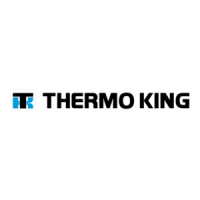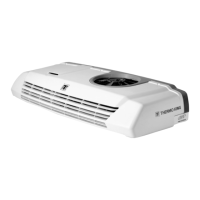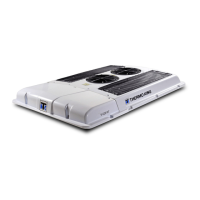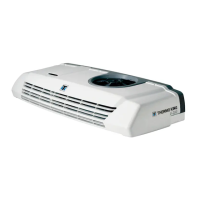Do you have a question about the Thermo King VM-405 Max EL and is the answer not in the manual?
Covers general safety information and specific hazards.
Details standards for installing unit components.
Covers compressor selection and installation requirements.
Defines standards for hoses and fittings.
Outlines electrical connection standards.
Outlines unit evacuation procedures.
Details leak check procedures.
Outlines refrigerant charging procedures.
Provides a general overview of safety precautions for unit installation.
Defines the different types of safety advisories used throughout the manual.
General safety information and practices to follow during installation and service.
Warns about hazards associated with moving parts and equipment.
Details risks associated with refrigerant vapor inhalation.
Stresses the importance of wearing PPE when working with the unit.
Ensures service equipment is in good condition to prevent injury.
Highlights risks of equipment damage due to improper installation or handling.
Warns about potential hazards from automatic unit start-up.
Details hazards related to refrigerant pressure and gases.
Highlights risks and precautions when handling refrigerant oil.
Details dangers associated with hazardous voltages and live components.
Warns about explosion risks during battery removal and reconnection.
Advises on precautions before performing electric welding on the unit.
Provides procedures for working with microprocessor-based control systems.
Offers first aid instructions for exposure to refrigerant, oil, coolant, and electrical shock.
Advises to observe all safety decals placed on the unit.
Specifies requirements for the cargo box for refrigeration applications.
Advises on accessing unit-specific installation manuals online.
Describes the use of paper templates for accurate component mounting.
Provides guidance on unpacking and checking components for damage or missing parts.
Details procedures and precautions for drilling holes in the vehicle or cargo box.
Emphasizes sealing all holes to prevent air/water leakage.
Lists acceptable methods for sealing holes and component mounts.
Details steps for sealing access holes for hoses and harnesses.
Covers proper selection and use of mounting hardware.
Specifies requirements for hardware threads, grade, and finish.
Details correct hardware length requirements for applications.
Specifies correct nut and washer requirements.
Provides guidance on securely tightening mounting hardware.
Describes available versions of vehicle powered truck units.
Details the design and installation of nosemount units.
Details the design and installation of rooftop mounted units.
Highlights common requirements for nosemount and rooftop split systems.
Provides the recommended installation sequence for vehicle powered units.
Outlines refrigerant charging procedures for optimal performance.
Covers general safety information and specific hazards.
Details standards for installing unit components.
Covers compressor selection and installation requirements.
Defines standards for hoses and fittings.
Outlines electrical connection standards.
Outlines unit evacuation procedures.
Details leak check procedures.
Outlines refrigerant charging procedures.
Provides a general overview of safety precautions for unit installation.
Defines the different types of safety advisories used throughout the manual.
General safety information and practices to follow during installation and service.
Warns about hazards associated with moving parts and equipment.
Details risks associated with refrigerant vapor inhalation.
Stresses the importance of wearing PPE when working with the unit.
Ensures service equipment is in good condition to prevent injury.
Highlights risks of equipment damage due to improper installation or handling.
Warns about potential hazards from automatic unit start-up.
Details hazards related to refrigerant pressure and gases.
Highlights risks and precautions when handling refrigerant oil.
Details dangers associated with hazardous voltages and live components.
Warns about explosion risks during battery removal and reconnection.
Advises on precautions before performing electric welding on the unit.
Provides procedures for working with microprocessor-based control systems.
Offers first aid instructions for exposure to refrigerant, oil, coolant, and electrical shock.
Advises to observe all safety decals placed on the unit.
Specifies requirements for the cargo box for refrigeration applications.
Advises on accessing unit-specific installation manuals online.
Describes the use of paper templates for accurate component mounting.
Provides guidance on unpacking and checking components for damage or missing parts.
Details procedures and precautions for drilling holes in the vehicle or cargo box.
Emphasizes sealing all holes to prevent air/water leakage.
Lists acceptable methods for sealing holes and component mounts.
Details steps for sealing access holes for hoses and harnesses.
Covers proper selection and use of mounting hardware.
Specifies requirements for hardware threads, grade, and finish.
Details correct hardware length requirements for applications.
Specifies correct nut and washer requirements.
Provides guidance on securely tightening mounting hardware.
Describes available versions of vehicle powered truck units.
Details the design and installation of nosemount units.
Details the design and installation of rooftop mounted units.
Highlights common requirements for nosemount and rooftop split systems.
Provides the recommended installation sequence for vehicle powered units.
Outlines refrigerant charging procedures for optimal performance.
| Brand | Thermo King |
|---|---|
| Model | VM-405 Max EL |
| Category | Automobile Accessories |
| Language | English |











